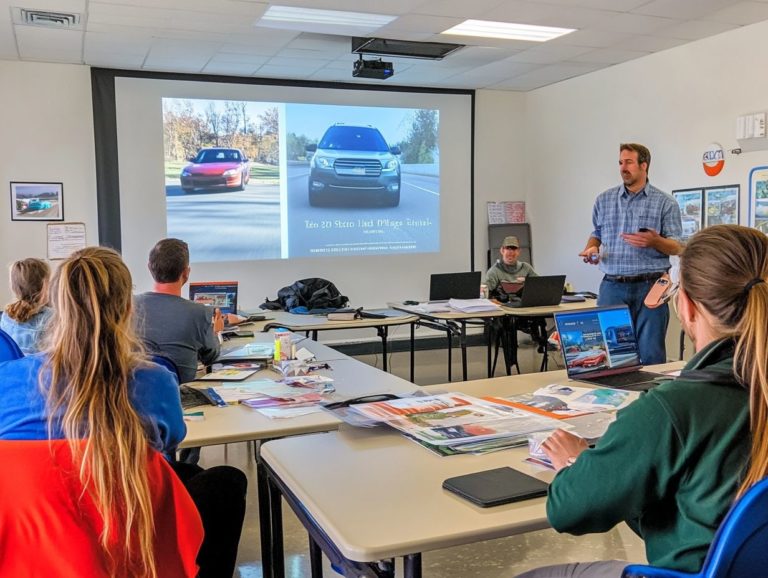How to Lower Your Premiums as a High-Risk Driver
Being categorized as a high-risk driver can be overwhelming, particularly when it comes to insurance premiums.
This discussion delves into what defines a high-risk driver and the consequences associated with that designation. It highlights effective strategies for reducing insurance costs, from improving your driving record to making savvy choices when shopping for policies.
You ll discover alternative insurance options tailored specifically for high-risk drivers, giving you more choices. Essential tips will empower you to cultivate good driving habits and navigate the insurance landscape with greater confidence.
Contents
Key Takeaways:

- High-risk drivers are those more likely to get into accidents or file claims, resulting in higher insurance premiums.
- Improving your driving record, shopping around for insurance, and exploring discounts can help lower your premiums.
- Non-standard insurance companies and state-sponsored programs are alternative options for high-risk drivers struggling to find coverage from traditional insurers.
Get to Know High-Risk Drivers: What You Need to Know!
Understanding high-risk drivers requires examining the myriad factors that contribute to this classification. A poor driving record, a history of accidents, and other significant elements can greatly influence auto insurance rates.
As a high-risk driver, you will likely encounter elevated insurance costs due to your past, which can limit your options while navigating the coverage landscape. It s crucial to understand the nuances of various insurance companies and assess the financial stability of providers such as Progressive, State Farm, and Geico, particularly in states like Michigan.
What Makes a Driver High-Risk?
Several factors classify you as a high-risk driver, including a poor driving record and multiple traffic violations. These elements invariably lead to higher auto insurance rates.
As a high-risk driver, you may face significant financial consequences from behaviors like excessive speeding tickets and driving under the influence (DUI). Each infraction adds layers of risk that insurance companies evaluate when assessing your claims history, resulting in skyrocketing premiums for collision coverage. For instance, just one DUI can dramatically raise your rates and potentially require mandatory SR-22 filings, a certificate proving you have car insurance, which can be a costly burden for high-risk individuals.
Keeping your driving record clean saves you money and keeps everyone safe! Not only does it help lower your insurance costs over time, but it also enhances overall road safety for you and the community.
Consequences of Being Labeled High-Risk
Being labeled a high-risk driver carries significant consequences, including soaring insurance premiums, limited coverage options, and potential hurdles in securing a policy from reputable insurers. To navigate these challenges, it’s important to explore understanding high-risk driver insurance options.
If you find yourself in this category, you ll likely face a substantial increase in your premium costs, which can seriously impact your financial health. This situation can hinder your ability to shop around for better quotes, as many insurance companies may hesitate to provide competitive offers due to the higher risk involved.
You might also encounter a barrage of consumer complaints linked to your driving history, complicating your quest for adequate coverage. Ultimately, the ramifications of being deemed high-risk extend beyond mere insurance rates; they can also affect your overall financial stability and long-term planning.
Ways to Lower Your Premiums
Lowering auto insurance premiums is essential for high-risk drivers, and this can be achieved through strategies for managing insurance costs.
Consider improving your driving record, as this can significantly affect your rates. Take the time to shop around for better deals; there are often more competitive options available.
Explore various insurance discounts to offset rising costs and make a tangible difference in your premiums.
Don t wait! Start improving your driving record today to save on your insurance costs!
Improving Your Driving Record

Improving your driving record is crucial, especially if you’re considered a high-risk driver. Embracing safe driving practices and completing a defensive driving course which teaches skills to avoid accidents can help you reduce your insurance costs and qualify for various discounts.
When you adopt responsible habits like obeying speed limits, steering clear of distractions, and anticipating the actions of other drivers, you create a safer driving environment for everyone. Taking a defensive driving course sharpens your skills and often leads to direct reductions in your insurance premiums. Insurers value these safe driving actions when evaluating your quotes.
By maintaining a clean driving record over time, you may unlock more favorable rates. Consistent safe driving can lead to real financial rewards. Highlighting these positive changes can significantly impact your long-term insurance costs.
Shopping Around for Insurance
Shopping around for car insurance is essential for high-risk drivers like you. By exploring insurance discounts available for high-risk drivers, comparing quotes online from different companies can reveal significant differences in coverage options and rates, helping you save money.
Thorough research helps you understand the specific terms and conditions tied to each plan. This knowledge enables you to make informed decisions about coverage that suits your unique needs.
Using online insurance comparison tools makes it easier to compare different offerings in one convenient place. High-risk drivers can find opportunities for substantial savings, allowing them to secure coverage that might otherwise feel financially out of reach.
Taking Advantage of Discounts
If you re a high-risk driver, you can save a lot of money! Explore various insurance discounts tailored just for you. These may include:
- Low mileage discounts
- Rewards for completing defensive driving courses
- Other financial incentives to encourage safer driving habits
Take USAA as an example; they offer exclusive discounts for military families. Meanwhile, Erie Insurance rewards those who successfully finish their safe-driving programs. Participating in these initiatives not only trims your insurance premiums but also promotes positive driving behaviors that enhance road safety.
As you lower your insurance costs through these programs, you’ll achieve greater financial stability, freeing up resources for other essential needs. Such proactive measures foster a culture of safety that benefits not just you, but the entire community.
Explore Better Insurance Choices for High-Risk Drivers
For high-risk drivers searching for auto insurance, a range of alternative options awaits you. Non-standard insurance companies and state-sponsored programs are designed to meet your specific needs and challenges, providing suitable coverage.
Non-Standard Insurance Companies
Non-standard insurance companies cater to high-risk drivers, offering specialized auto insurance options typically unavailable with traditional insurers.
These providers understand the unique challenges of individuals who may have previous accidents, DUIs, or other circumstances that categorize them as risky on the road. By tailoring their approach, non-standard insurers develop policy options that cater to varying levels of coverage and costs specific to your needs.
While choosing such a provider might lead to higher premiums compared to standard policies, you often gain benefits like flexible payment plans. However, consider the potential drawbacks, like limited coverage options and higher deductibles. Careful consideration is crucial to ensure you select the right coverage for your situation.
State-Sponsored Insurance Programs

State-sponsored insurance programs offer essential coverage options for high-risk drivers in need of auto insurance, especially in states like Michigan, where traditional market choices can be somewhat limited.
These programs serve as a crucial safety net for individuals who might find it challenging to secure coverage due to previous accidents, traffic violations, or other risk factors. If you’re considered a high-risk driver, you’re likely all too familiar with the significantly higher premiums in the private market. Understanding the long-term costs of being a high-risk driver makes state-sponsored options a compelling alternative. Typically, you’ll need to show that you live in the state and may have to provide financial assessments to confirm that you genuinely need assistance.
While these programs provide a pathway to necessary auto insurance, they might also come with certain restrictions, such as minimum coverage levels and limitations on policy benefits. Ultimately, state-sponsored insurance plays an important part in boosting financial stability within the auto insurance landscape. This ensures that those who may otherwise slip through the cracks have access to the coverage they need.
Final Tips for High-Risk Drivers
For high-risk drivers, developing good driving habits and taking a proactive approach to insurance coverage are vital strategies. Understanding how to understand your policy as a high-risk driver can significantly enhance your financial stability and elevate your overall satisfaction with your insurance provider.
Maintaining Good Driving Habits
Maintaining good driving habits is essential for high-risk drivers like you. Consistently practicing safe driving can dramatically reduce the likelihood of accidents and may even help you find the best low-cost insurance policies for high-risk drivers that offer valuable discounts.
By sticking to speed limits, you not only enhance your own safety but also demonstrate to insurers that you re responsible behind the wheel. Steering clear of distractions, such as mobile devices, further emphasizes your commitment to focused driving, significantly lowering the chances of unexpected mishaps.
Enrolling in defensive driving courses can arm you with vital skills to anticipate and react appropriately to potential hazards on the road. Over time, embracing these positive behaviors can lead to fewer collisions. This can ultimately result in lower insurance premiums as insurers recognize your improved risk profile and reward you accordingly.
Being Proactive About Insurance Coverage
As a high-risk driver, it’s essential for you to take a proactive stance on your insurance coverage. Regularly reviewing your policies and consulting with insurance agents can help you navigate the insurance market to ensure that you have adequate protection and access to the best rates available.
This strategy not only shields you from unexpected liabilities but also enables you to make informed decisions about your financial well-being. By frequently reviewing your policy, you can pinpoint any gaps in coverage, which are areas where your insurance may not fully protect you, and make necessary adjustments that align with your current driving habits or life changes.
Talking openly with your insurance agents can help cultivate a relationship that yields tailored advice, particularly vital for those classified as high-risk. In doing so, you may uncover opportunities for better rates and discounts, ultimately boosting your financial health while remaining compliant with legal requirements.
Frequently Asked Questions
What does it mean to be a high-risk driver?

A high-risk driver is someone who is considered to have a higher likelihood of being involved in accidents or filing insurance claims. This can be due to a history of traffic violations, accidents, or other factors that make them riskier to insure.
One way to lower your premiums is to take a defensive driving course. This shows insurance companies that you are committed to improving your driving skills and can lead to a discount on your premiums.
Yes, it is always a good idea to shop around and compare quotes from different insurance companies. Some companies may specialize in insuring high-risk drivers and may offer lower premiums than your current provider.
Your driving history is just one part of the equation. Factors like your age, vehicle type, and credit score also play a role.
Many insurance companies offer discounts! You could save by bundling policies, having safety features, or maintaining a clean driving record.
If your premiums are too high, consider adjusting your insurance amount or increasing your deductibles. Make sure you have at least the minimum required coverage and discuss options with your insurance provider for a better deal!





